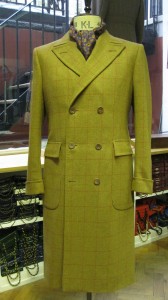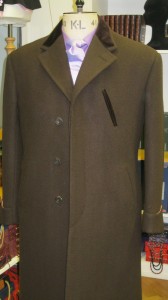Get your overcoats out!……
It is now the season for the ever faithful overcoat. Lets face it, the overcoat is neglected for a large part of the year. Then when it is in use, you wear it every day! Yet, it stays faithful to you. If you treated your girlfriend like this, you would have chilblains by now!! So, this is why it is important to choose your choice of overcoat wisely.
The choice of cloth is really the first thing to consider. Think about how heavy and dense the cloth needs to be to keep you warm through winter, whether its is Siberian or Californian. Cashmere is beautifully soft and warm, but cannot withstand heavy wear. All wool coating is hard wearing and is made in a wide variety of weights. The middle man is a cashmere and wool mix. Which, shares the pro and cons of either cloth. Heavy oily tweeds are great for making overcoats, as tweed is designed for the purpose of outdoor use. The natural oils from the sheep, still present in the woven tweed help repel light rain and mists.

Then comes style. For rather cold climates, double breasted overcoats with deep collars and lapels to turn up against the wind. Cavernous pockets lined in velvet for cold hands. For milder winters, perhaps single breasted with high buttoning. A velvet collar to grip the back of the neck for comfort on windy days. Selvyt pocketing for a lighter, but still warm option.

The weight of the linings is another factor. The heaviest weight is a cotton back lining. Satin lining is a middle weight and ermazine is the lightest. Silk is not recommended for lining an overcoat. Silk is a great retainer of heat, but the delicate nature makes it too weak to use in overcoats.
So, when you find yourself standing in the cold, what would be your perfect overcoat?
Toodle pip! Celia.

